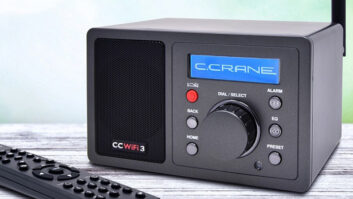LONDON — When internet radio was first developed in the 1990s, the first broadcasts were heard on web-connected computers. But few at the time doubted that “traditionally-styled standalone internet radios” — internet appliances styled like conventional AM/FM radios that could tune to streaming audio services — would be the inevitable destinations for this content. After all, the public was already accustomed to hearing MW (AM) and FM broadcasts on such radios. Surely the best way to ease them into internet radio was by marrying this new medium with a form factor that they knew so well.

The Roberts R100 Smart Radio comes with wireless speaker and multiroom capability.
Credit: Roberts Radio

The Roberts R100 Smart Radio’s color interface allows the listener to choose between DAB, FM, internet radio or music streaming mode.
Credit: Roberts Radio
RECEIVERS
This logic has driven the development of consumer DAB/DAB+ receivers around the world, and it has worked. In fact, one reason why listeners in Asia and Europe have accepted DAB/DAB+ is because DAB/DAB+ receivers look and (as much as possible) function like the traditionally styled MW/FM radios they’re accustomed to.
The growth of internet radio listening is a global success story; driven in part by the popularity of streaming audio services such as Pandora, Slacker and Spotify (even though some of those services are having trouble turning a profit). Yet, judging by the declining number of standalone internet radios available for purchase these days (versus a few years ago), this specific technology is not enjoying a similar level of success. In fact, companies such as Acoustic Research and Sanyo have ceased making internet radios. Others such as Grace Digital have scaled back the number of standalone internet radios they have for sale.
But is the traditionally styled standalone internet radio receiver actually on its way out? To find out, RadioNet contacted five companies who make streaming audio receivers. They are C. Crane Company (U.S.), Grace Digital (U.S.), Ocean Digital Technology (Hong Kong), Roberts Radio (U.K.) and Ruark Audio (U.K.).
IN DECLINE OR NOT?
First things first: Are traditionally styled standalone internet radios in decline?
According to Grace Digital CEO and Co-Founder Greg Fadul, the answer is yes. “I do think the number of companies making classic-looking internet-enabled style radios is decreasing,” Fadul said; “although at Grace we just launched a brand new one (the Mondo+) and have additional units coming down the pipe later this year.”

The Ocean Digital WR60 internet radio also accesses FM.
Credit: Ocean Digital Technology

The Ocean Digital WR210CB internet radio supports up to 250 station presets.
Credit: Ocean Digital Technology

The Ocean Digital WR282 internet radio also tunes to FM, and has a wooden case.
Credit: Ocean Digital Technology
Ocean Digital Technology’s Kevin Champion, the company’s sales manager for e-Commerce, agreed that some manufacturers are exiting the standalone internet radio market. But he credits their departures to an unwillingness to take risks in the marketplace, rather than due to a drop in consumer demand for standalone internet radios. (Ocean Digital currently offers three standalone models.) “Different companies have different expectations on ROI [return on investment] and scales of production,” explained Champion.
For his part, Richard McKinney, sales director at Ruark Audio, doesn’t think “there is necessarily a decline taking place.” Rather, “I feel it is more a shift from dedicated internet receivers to streaming products which have internet radio listed in the spec as one of the functions,” he said.
Roberts Radio has chosen to package “Bluetooth streaming” (a.k.a. internet radio) as one of many features offered in its line of traditionally styled desktop and portable radios; along with DAB/DAB+ and FM. The payoff: “In the U.K. where Roberts conduct the majority of our business, the internet radio segment — although it is predominantly internet and DAB/DAB+ integrated — is in growth, albeit quite gradual growth,” said Rachel Cowle Roberts Radio’s head of PR and marketing.
The same gradual sales growth is occurring at C. Crane Co., a California-based, family-owned specialty electronics designer/vendor. “C. Crane is seeing an upward trend in internet radio and the technology is expanding slightly,” said Bob Crane, founder of C. Crane Company. This said, “A standalone device for audio is a luxury item and should grow with time.”
MULTIPLE PLATFORMS
Although the five equipment manufacturers above appear to be taking different positions, they all agree that the standalone internet radio isn’t wowing consumers; at least not in comparison to appliances that can receive internet radio plus DAB/DAB+ and FM.

Grace Digital’s Mondo+ internet radio comes with Google’s Chromecast platform built in.
Credit: Grace Digital
“In the U.K., DAB/ DAB+ has definitely hampered the growth of standalone internet radios,” said Ruark Audio’s McKinney. “Out of all our products, it’s the DAB/DAB+ Bluetooth R1MK3 which has shown the best results in terms of sales with a year-on-year growth of around 15 percent. The integration of Bluetooth receivers in DAB/DAB+ radios will have also played a major part in this; enabling the end user to stream their favorite internet radio stations from their smart devices using free apps like TuneIn.”
The power of serving multiple content platforms is why Grace Digital’s new Mondo+ internet radio comes with Google’s Chromecast built in; a first for this company’s line of internet-enabled receivers. This new feature allows listeners to stream Chromecast content directly from their smartphones (when loaded with the Chromecast app) directly to their Mondo+; with no wired or Wi-Fi internet connection being required. “The new Mondo+ can also deliver any audio source available to one radio — including Bluetooth — to an unlimited number of other Wi-Fi-connected speakers/radios in other rooms, to compete with multiroom systems being made by Bose and Sonos,” said Fadul.
Grace Digital’s decision to offer multiple platforms and capabilities within the new Mondo+ is in line with consumer trends. “When you look at the areas of growth in our sector it’s all about smart home technology,” said McKinney. “Consumers want choice and a product that will do everything; e.g. DAB, internet and streaming. Consumers want to cover all bases so can they have confidence that the product they’ve just invested in is future proof.”

The C. Crane CC WiFi internet radio can be used as a standalone receiver, or connected to a home stereo system for enhanced audio quality.
Credit: C. Crane
But not everyone agrees that multiple platform radios are king. “In fact, we believe there is room for both kinds of internet radio,” said Crane. “Many radio listeners are not ready for this evolving technology and are still in need of a standalone internet radio model that is simple and basic to start with.”
One thing is certain: Standalone internet radios are up against a formidable competitor in the form of smartphones. These personal wireless devices are now being used to stream audio to Bluetooth speakers and Bluetooth-connected car audio systems.
Such is the penetration and power of smartphones, that car audio equipment manufacturers are comfortable relying on this third-party hardware to provide the link between cars and the internet; rather than building such linking technology into this equipment. Of course, using smartphones for in-car connectivity also saves these manufacturers money.
“Listening ‘on the go’ is no doubt a major contributor to the shift in listening habits with smartphones being a major factor,” said McKinney. “We are finding more and more of our customers are using their smartphones as a source for all their audio needs, whether it be radio or streaming from another music platform such as Spotify.”
However, smartphone-base audio streaming does have its downside. Specifically, “Smartphones, as we know, are app-based,” said Crane. “I myself find that switching apps to stream a different station or host is very frustrating and time-consuming, especially while listening late at night. Having a standalone streaming internet radio with presets and a remote makes listening to internet radio more convenient.”

Ruark Audio’s R1MK3 receiver offers DAB/DAB+, FM and access to streaming audio.
Credit: Ruark Audio
THE FUTURE
Multiple content platforms and the ubiquity of smartphones are two forces that no one could have foreseen 20 years ago, when the concept of the traditionally styled standalone internet radio was born. So what do they mean to the future of standalone internet radios, and what can be done to improve its odds?
As far as Ocean Digital’s Kevin Champion is concerned, the salvation of standalone internet radios lies in offering better functionality, and a more consumer-friendly design. “Bigger and color screens on internet radios are getting more popular,” he said. “But an improvement of the password-setting method will surely help as well.”
Champion also believes that consumers need to be better educated about the benefits of standalone internet radios, for this technology to reach its full sales potential. Roberts Radio’s Cowle shares this view. “There is clearly room for more growth in internet radio, and a key challenge for us is helping the end customer to understand the benefits with support and investment from retailers,” he said.
“We find consumers don’t understand what internet radio is and how it works, so they sometimes make assumptions that it will not fit into their lifestyle or radio listening habits,” agreed Bob Crane. “When actually seen and used, most people buy one or want one.”
As for standalone internet radios being doomed to eventual obsolescence, as an outdated concept whose time has already come and gone? Based on the feedback from these five manufacturers, the answer is “No.”
“What’s happening is the exact opposite,” said Crane. “Once the concept of standalone internet radio is understood, consumers are eager to get their hands on the ‘newest toy.’”
“Best Buy still sells millions of clock radios without internet connectivity, and tons of Sonos, which are standalone receivers without a display,” said Greg Fadul. “So the classic internet radio receiver will always be needed, even though I doubt it will ever turn into a massively large market.”
“That being said, there are rumors that the big boys may soon be launching internet-enabled speakers with displays,” Fadul added with a smile. “That’s an internet radio, right?”
James Careless reports on the industry for Radio World from Ottawa, Ontario.







